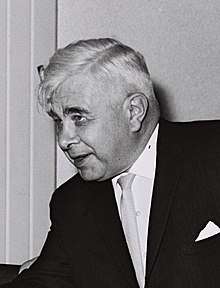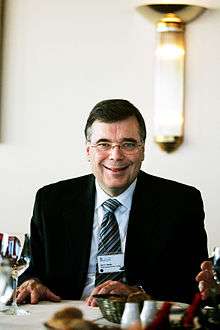Independence Party (Iceland)
The Independence Party (Icelandic: Sjálfstæðisflokkurinn) is a liberal-conservative[6][7] and Eurosceptic[7][8][9] political party in Iceland. It is currently the largest party in the Alþingi, with 16 seats. The chairman of the party is Bjarni Benediktsson. The secretary of the party is Áslaug Arna Sigurbjörnsdóttir.
Independence Party Sjálfstæðisflokkurinn | |
|---|---|
 | |
| Chairperson | Bjarni Benediktsson |
| Vice-chairperson | Þórdís Kolbrún R. Gylfadóttir |
| Secretary | Áslaug Arna Sigurbjörnsdóttir |
| CEO | Þórður Þórarinsson |
| Founded | 25 May 1929 |
| Merger of | Conservative Party Liberal Party |
| Headquarters | Háaleitisbraut 1, 105 Reykjavík |
| Youth wing | Young Independents |
| Ideology | Liberal conservatism Economic liberalism Euroscepticism |
| Political position | Centre-right[1][2][3] to right-wing[4][5] |
| European affiliation | European Conservatives and Reformists Party |
| International affiliation | International Democrat Union |
| Nordic affiliation | Conservative Group |
| Colours | Blue |
| Seats in Parliament | 16 / 63 |
| Election symbol | |
| D | |
| Website | |
| xd | |
It was formed in 1929 through a merger of the Conservative Party and the Liberal Party. This united the two parties advocating the dissolution of the Union of Denmark and Iceland; dissolution was achieved in 1944, during the German occupation of Denmark. From 1929, the party won the largest share of the vote in every election until the 2009 election, when it fell behind the Social Democratic Alliance. Until Bjarni took the leadership after the 2009 defeat, every Independence Party leader has also held the office of Prime Minister. Since 2013, the Independence Party has joined the coalition government.
The Independence Party broadly encompasses all centre-right thought in Iceland. Economically liberal[10] and opposed to interventionism, the party is supported most strongly by fishermen and high-earners,[11] particularly in Reykjavík.[12] It supports Icelandic membership of NATO but opposes the idea of joining the European Union (EU). It is a member of the International Democrat Union, and it joined the Alliance of European Conservatives and Reformists (AECR) in November 2011, a centre-right Eurosceptic European political party.
History
The Independence Party was founded on 25 May 1929 through a merger of the Conservative Party and the Liberal Party. It readopted the name of the historical Independence Party, which had split between the Conservatives and Liberals in 1927.[13] From its first election, in 1931, it was the largest party in Iceland.[14]
The Independence Party won the 2007 elections, increasing their seat tally in the Althing by 3. It formed a new coalition government under Geir Haarde with the Social Democratic Alliance, after the Progressive Party lost heavily in the elections. In the 2009 elections, the party dropped from 25–26 to 16 seats in the Althing, becoming Iceland's second-largest party following the Social Democratic Alliance (which gained two seats, to 20.)
The Independence Party re-entered government after the general elections in 2013, gaining 19 seats in parliament and the most votes again becoming Iceland's largest party. The Independence Party hence formed a majority government with the Progressive Party with Bjarni becoming Minister of Finance and Economic Affairs under the premiership of Sigmundur Davíð Gunnlaugsson chairman of the Progressive Party. The government coalition was ended after the Panama Papers revealed that Sigmundur Davíð Gunnlaugsson, Bjarni Benediktsson and other known members of the Independence Party held funds in offshore bank accounts. The general election in 2016 yielded a government consisting of the Independence Party, Bright Future and the Reform Party. With the Independence Party holding 21 seats in Parliament. That government then proceeded to fall apart due to Bjarni Benediktsson's father's ties to a convicted child sex offender that had his criminal records cleared by the Minister of the interior, an Independence Party MP. After the general elections 2017, called after much backlash from this decision, the Independence party formed a new government with the Left-Green Movement and the Progressive Party. The Independence Party now holds 16 seats in Parliament.
Ideology
The party has been the sole major politically right-leaning party in Iceland since its inception, and has captured a broad cross-section of centre-right voters. As a result, the party is not as far to the right as most right-wing parties in Scandinavia, serving as a 'catch-all' party.[15] The party, like the British Conservatives, states a claim to be primarily 'pragmatic', as opposed to ideological,[11][12][16] and its name is seen as an allusion to being independent of dogma (the original meaning - independence from Denmark - having been achieved long ago).[17] For most of its period of political dominance, the party has relied upon coalition government, and has made coalitions with many major parties in parliament.[18]
The Independence Party has generally been economically liberal and advocated limited government intervention in the economy.[11] It was originally committed to laissez-faire economics, but shifted its economic policies left-wards in the 1930s, accepting the creation of a welfare state.[12]
The party is social liberal on social issues and has historically been less conservative than other centre-right parties in Scandinavia.[12] The party was the only consistent advocate for the end of prohibition of beer, and provided three-quarters of voters in favour of legalisation; the ban was lifted in 1989.[19]
The party's skeptic position on EU membership was confirmed at its national congress in March 2009.[20] Its near-permanent position as Iceland's largest party has guaranteed Iceland's Atlanticist stance.[21] The party is in favour of allowing Icelanders to participate in peacekeeping missions, including in Afghanistan.[22]
Political support
 |
|---|
| This article is part of a series on the politics and government of Iceland |
| Constitution |
|
Institutions |
|
|
|
|
Historically, the party has been the most successful liberal conservative party in the Nordic countries.[15] It has a broad base of support, but is most strongly supported by Iceland's large fishing community and by businesses.[11] On the largest divide in Icelandic politics, between urban and rural areas, the Independence Party is firmly supported by rural areas, but its urban support is mostly found in Garðabær and Kópavogur.
The Independence Party has always attempted to avoid appealing to a specific social class.[23] As such, the party is relatively successful at attracting working-class voters,[18] which partly comes from the party's strong advocacy of independence in the 1930s.[24] However, most of its strength is in the middle class,[19][25] and the party is disproportionately supported by those on high incomes and those with university educations.[11]
The party has long been endorsed by Morgunblaðið,[19] an Icelandic newspaper of record.[26] Davíð Oddsson, the longest-serving Prime Minister, is one of two editors of the paper. The paper was also historically supported by the afternoon newspaper Vísir, now part of DV.[12]
Organisation
The party has a tradition of individualism and strong personalities, which has proven difficult for the leadership to manage. The Commonwealth Party split in 1941, while the Republican Party left in 1953, both in opposition to the leftwards shift of the party away from classical liberalism.[12] Neither splinter group managed to get seats in Althingi and both vanished quickly. The Citizens' Party split from the party in 1983, but collapsed in 1994.[16]
Its youth wing, Young Independents, is by far the largest youth organisation in Iceland, with over 12,000 members. It is slightly more classically liberal than the senior party.[27]
The party has a very large membership base, with 15% of the total population being a member of the party.[28]
International relations
For years the Independence party was a member of the EPP that include members like Høyre (Norway), Moderate Party (Sweden), les Républicains (France), the Kokoomus (Finland), and CDU (Germany). But with a new more Eurosceptic leadership of the party it joined the Alliance of European Conservatives and Reformists (AECR) in November 2011, a centre-right Eurosceptic political organization. Members of the AECR, includes among others, the British Conservative Party, Polish Law and Justice, and the Czech Civic Democratic Party.
Election results
| Election | Votes | % | Seats | +/– | Position | Government |
|---|---|---|---|---|---|---|
| 1931 | 16,891 | 43.8 | 15 / 42 |
Opposition | ||
| 1933 | 17,131 | 48.0 | 20 / 42 |
Coalition | ||
| 1934 | 21,974 | 42.3 | 20 / 49 |
Opposition | ||
| 1937 | 24,132 | 41.3 | 17 / 49 |
Opposition | ||
| 1942 (Jul) | 22,975 | 39.5 | 17 / 49 |
Minority | ||
| 1942 (Oct) | 23,001 | 38.5 | 20 / 52 |
Opposition | ||
| 1946 | 26,428 | 39.5 | 20 / 52 |
Coalition | ||
| 1949 | 28,546 | 39.5 | 19 / 52 |
Minority | ||
| 1953 | 28,738 | 37.1 | 21 / 52 |
Coalition | ||
| 1956 | 35,027 | 42.4 | 19 / 52 |
Opposition | ||
| 1959 (Jun) | 36,029 | 42.5 | 20 / 52 |
Opposition | ||
| 1959 (Oct) | 33,800 | 39.7 | 24 / 60 |
Coalition | ||
| 1963 | 37,021 | 41.4 | 24 / 60 |
Coalition | ||
| 1967 | 36,036 | 37.5 | 23 / 60 |
Coalition | ||
| 1971 | 38,170 | 36.2 | 22 / 60 |
Opposition | ||
| 1974 | 48,764 | 42.7 | 25 / 60 |
Coalition | ||
| 1978 | 39,982 | 32.7 | 20 / 60 |
Opposition | ||
| 1979 | 43,838 | 35.4 | 21 / 60 |
Opposition | ||
| 1983 | 50,251 | 38.6 | 23 / 60 |
Coalition | ||
| 1987 | 41,490 | 27.2 | 18 / 63 |
Coalition | ||
| 1991 | 60,836 | 38.6 | 26 / 63 |
Coalition | ||
| 1995 | 61,183 | 37.1 | 25 / 63 |
Coalition | ||
| 1999 | 67,513 | 40.7 | 26 / 63 |
Coalition | ||
| 2003 | 61,701 | 33.6 | 22 / 63 |
Coalition | ||
| 2007 | 66,754 | 36.6 | 25 / 63 |
Coalition | ||
| 2009 | 44,371 | 23.7 | 16 / 63 |
Opposition | ||
| 2013 | 50,454 | 26.7 | 19 / 63 |
Coalition | ||
| 2016 | 54,990 | 29.0 | 21 / 63 |
Coalition | ||
| 2017 | 49,543 | 25.2 | 16 / 63 |
Coalition |
Leadership
| Nº | Chairman | Took office | Left office | Duration | |
|---|---|---|---|---|---|
| 1 |  |
Jón Þorláksson (1877–1935) |
29 May 1929 | 2 October 1934 | 5 years, 4 months, 3 days (1,952 days) |
| 2 |  |
Ólafur Thors (1892–1964) |
2 October 1934 | 22 October 1961 | 27 years, 20 days (9,882 days) |
| 3 |  |
Bjarni Benediktsson (1908–1970) |
22 October 1961 | 10 July 1970 | 8 years, 8 months, 18 days (3,183 days) |
| 4 |  |
Jóhann Hafstein (1915–1980) |
10 July 1970 | 12 October 1973 | 3 years, 3 months, 2 days (1,190 days) |
| 5 |  |
Geir Hallgrímsson (1925–1990) |
12 October 1973 | 6 November 1983 | 10 years, 25 days (3,677 days) |
| 6 |  |
Þorsteinn Pálsson (1947) |
6 November 1983 | 10 March 1991 | 7 years, 4 months, 4 days (2,681 days) |
| 7 |  |
Davíð Oddsson (1948) |
10 March 1991 | 16 October 2005 | 14 years, 7 months, 6 days (5,334 days) |
| 8 |  |
Geir Haarde (1951) |
16 October 2005 | 29 March 2009 | 3 years, 5 months, 13 days (1,260 days) |
| 9 |  |
Bjarni Benediktsson (1970) |
29 March 2009 | Present | 11 years, 91 days (4109 days) |
Footnotes
- Nordic States and European Integration: Awkward Partners in the North? p.106. Edited by Malin Stegmann McCallion and Alex Brianson. Published by Palgrave Macmillan. First published in 2017. Published in Cham, Switzerland. Accessed via Google Books.
- "Iceland election: Independence Party still has most seats". BBC News. 29 October 2017. Retrieved 30 October 2017.
- https://icelandmonitor.mbl.is/news/politics_and_society/2016/03/09/politics_in_iceland_a_beginner_s_guide/
- Önnudóttir, Eva H.; Hardarson, Ólafur Th. (11 December 2017). "Iceland 2017: A new government from left to right". Party Systems and Governments Observatory. University of Nottingham.
- Deloy, Corinne (2 May 2013). "The rightwing opposition wins in the general elections in Iceland". Robert Schuman Foundation.
- Agust Thor Arnason (2006). "The European Union Seen From the Top – A View of an Inside-Outsider". In Joakim Nergelius (ed.). Nordic and Other European Constitutional Traditions. BRILL. p. 34. ISBN 978-90-474-0978-6.
- Nordsieck, Wolfram (2017). "Iceland". Parties and Elections in Europe.
- Steed, Michael (1988). "Identifying Liberal Parties". In Kirchner, Emil Joseph (ed.). Liberal Parties in Western Europe. Cambridge: Cambridge University Press. pp. 376–95. ISBN 978-0-521-32394-9.
- Nergelius, Joakim (2006). Nordic and other European constitutional traditions. Leiden: Martinus Nijhoff Publishers. p. 34. ISBN 978-90-04-15171-0.
- Siaroff, Alan, The Effects of Differing Electoral Systems on Party Politics, Government Formation and Voter Turnout, p. 69
- Siaroff, Alan (2000). Comparative European party systems: an analysis of parliamentary elections. London: Taylor & Francis. p. 295. ISBN 978-0-8153-2930-5.
- Tomasson (1980), p. 42
- McHale, Vincent E.; Skowronski, Sharon (1983). Political Parties of Europe: Albania-Norway. Ann Arbor: University of Michigan Press. p. 522. ISBN 978-0-313-23804-8.
- Tomasson (1980), pp. 41–2
- Hansen, Erik Jørgen (2006). Welfare trends in the Scandinavian countries, Part 2. New York: M. E. Sharpe. p. 81. ISBN 978-0-87332-844-9.
- Cross, William (2007). Democratic reform in New Brunswick. Toronto: Canadian Scholars' Press. pp. 68–9. ISBN 978-1-55130-326-0.
- Woods, Leigh; Gunnarsdóttir, Ágústa (1997). Public Selves and Political Stages. London: Routledge. p. 10. ISBN 978-3-7186-5873-2.
- Arter, David (2006). Democracy in Scandinavia. Manchester: Manchester University Press. p. 50. ISBN 978-0-7190-7047-1.
- Gunnlaugsson, Helgi; Galliher, John F. (2000). Wayward Icelanders. Madison: University of Wisconsin Press. p. 39. ISBN 978-0-299-16534-5.
- "Ályktun um Evrópumál samþykkt".
- Bailes, Alyson J. K.; Herolf, Gunilla; Sundelius, Bengt (2006). The Nordic countries and the European Security and Defence Policy. Oxford: Oxford University Press. p. 329. ISBN 978-0-19-929084-0.
- Malley-Morrison, Kathleen (2009). State Violence and the Right to Peace. Santa Barbara: ABC-CLIO. p. 92. ISBN 978-0-275-99651-2.
- Jónsson, Ásgeir (2009). Why Iceland?. New York: McGraw-Hill. p. 140. ISBN 978-0-07-163284-3.
- Arter, David (1999). Scandinavian politics today. Manchester: Manchester University Press. p. 91. ISBN 978-0-7190-5133-3.
- Gill, Derek; Ingman, Stanley R. (1994). Eldercare, distributive justice, and the welfare state. Albany: State University of New York Press. p. 90. ISBN 978-0-7914-1765-2.
- Pálsson, Gísli (2007). Anthropology and the new genetics. Cambridge: Cambridge University Press. p. 132. ISBN 978-0-521-67174-3.
- "Vona að mitt framboð verði hvatning fyrir aðrar konur". Morgunblaðið (in Icelandic). 16 September 1997. Retrieved 27 November 2011.
- grapevine.is (3 April 2009). "The Independence Party featured in Grapevine Magazine". Grapevine.is. Retrieved 18 September 2017.
References
- Tomasson, Richard F. (1980). Iceland: The First New Society. Minneapolis: University of Minnesota Press. ISBN 978-0-8166-0913-0.
External links
- Official website
- The National Youth Organisation of the Independence Party, named Samband ungra sjálfstæðismanna or SUS in Icelandic, is one of the oldest political youth movements in Iceland.
- About the Independence Party